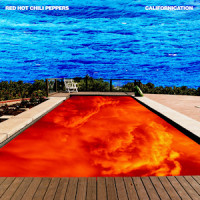When I announced that I wanted to review Californication for 90’s week, our esteemed reviews editor Jeff told me “I sure hope that Chili Peppers review is just three words long: ‘The absolute worst.’” Take note that he said nothing about someone claiming Limp Bizkit. It’s no secret that punks aren’t big fans of the Chili Peppers, but lately I feel like more and more people are jumping on that bandwagon of hate. On the NBC sitcom The Good Place there’s a quiz that characters take to determine if they belong in The Good Place (Heaven) or The Bad Place (Hell) and one of the questions is “Did you ever pay money to hear music by California funk-rock band The Red Hot Chili Peppers.” In the late-90’s, though, The Red Hot Chili Peppers were less despised and more forgotten, and a lot of it had to do with heroin.
The band’s entire history is riddled with tragic stories of drug use, including the death of founding guitarist Hillel Slovak in 1988. Following Slovak’s death the band took on John Frusciante as guitarist and replaced drummer Jack Irons with Chad Smith. This new lineup recorded two highly successful albums that brought them to widespread and mainstream popularity: Mother’s Milk and Blood Sugar Sex Magik. Unfortunately, John Frusciante fell into a deep heroin addiction that caused him to leave the band while touring to support Blood Sugar Sex Magik. Looking for a replacement, the band turned to Jane’s Addiction guitarist Dave Navarro following Jane’s Addiction’s first of many breakups. Despite the fact that Navarro is an exceptional guitarist, and was definitely one of the best in alternative rock at the time, he was a very poor fit for the band as he was not used to the “jamming” writing style and had significantly different influences from the band’s previous two guitarists. The band’s 1995 album, One Hot Minute was poorly received by critics and audiences alike and Navarro didn’t record with the band again. In 1999, the Red Hot Chili Peppers had some residual popularity from their late-80’s and early-90’s work, but they were hardly a “red hot” band at the time.
In the late-90’s, Frusciante had gotten clean and, when he was invited to rejoin the band, he was overwhelmed and started crying. With easily the band’s best lineup of their career back together, they set out to record Californication, and everything came back together in what I would consider one of the all-time great comeback albums. The album balances the band’s talents for hard and fast funk-rock numbers like “Around the World” and “Get on Top,” with slow and beautiful melodic ballads like “Scar Tissue” and “Otherside.” The album produced a blockbuster six singles and became their most commercially successful album of all time, selling primarily to a generation that hadn’t been around or had been very young the last time the band had been successful.
This core lineup would go on to record two more albums for a total of five before Frusciante would leave again, this time to focus on his solo career instead of drugs. The band continues on today with guitarist Josh Klinghoffer, who is only four years older than the band itself, and otherwise retains the lineup they had on Californication. The album remains a staple of their live shows and is remembered as their best album in the band’s long and storied career.
